The Major Constituent of Green Tea, Epigallocatechin-3-Gallate (EGCG), Inhibits the Growth of HPV18-Infected Keratinocytes by Stimulating Proteasomal Turnover of the E6 and E7 Oncoproteins
Abstract
1. Introduction
2. Results
2.1. The Cell Models: HFK-HPV18 and VIN cl.11
2.2. EGCG Inhibits Proliferation and Induces Apoptosis of HFK-HPV18 and VIN cl.11 Keratinocytes Grown in Monolayer Culture
2.3. EGCG Inhibits HFK-HPV18 and VIN cl.11 Proliferation in Organotypic Raft Culture
2.4. EGCG Downregulates the Expression of the E6 and E7 Viral Oncogenes by Enhancing Their Turnover
2.5. EGCG Downregulates the Viral Oncogenes E6 and E7, Leading to Re-Expression of Their Target TSGs
2.6. EGCG Promotes E6 and E7 Degradation through the Proteasome
2.7. Inhibition of E6 and E7 Expression by EGCG Impairs the Lytic Replication of HPV18
2.8. EGCG Treatment Does Not Grossly Affect Keratinocyte Differentiation
3. Discussion
4. Materials and Methods
4.1. Cell Lines
4.2. Establishment of a Primary uVIN-Derived Keratinocyte Cell Line
4.3. HPV Genotyping with Luminex PCR
4.4. Antibodies and Inhibitors
4.5. Cell Growth and Viability Assays
4.6. TUNEL Assay
4.7. Semi-Quantitative mRNA Analysis of E6/E7 Transcripts Using Real-Time PCR
4.8. Western Blot Analysis
4.9. Immunocytochemistry and In Situ Hybridization (ISH)
4.10. Organotypic Raft Cultures
4.11. Statistical Analysis
5. Conclusions
Supplementary Materials
Author Contributions
Funding
Institutional Review Board Statement
Informed Consent Statement
Data Availability Statement
Acknowledgments
Conflicts of Interest
References
- De Vuyst, H.; Clifford, G.M.; Nascimento, M.C.; Madeleine, M.M.; Franceschi, S. Prevalence and type distribution of human papillomavirus in carcinoma and intraepithelial neoplasia of the vulva, vagina and anus: A meta-analysis. Int. J. Cancer 2009, 124, 1626–1636. [Google Scholar] [CrossRef]
- Hillemanns, P.; Wang, X. Integration of HPV-16 and HPV-18 DNA in vulvar intraepithelial neoplasia. Gynecol. Oncol. 2006, 100, 276–282. [Google Scholar] [CrossRef]
- Judson, P.L.; Habermann, E.B.; Baxter, N.N.; Durham, S.B.; Virnig, B.A. Trends in the incidence of invasive and in situ vulvar carcinoma. Obstet. Gynecol. 2006, 107, 1018–1022. [Google Scholar] [CrossRef] [PubMed]
- Baandrup, L.; Varbo, A.; Munk, C.; Johansen, C.; Frisch, M.; Kjaer, S.K. In situ and invasive squamous cell carcinoma of the vulva in Denmark 1978–2007—A nationwide population-based study. Gynecol. Oncol. 2011, 122, 45–49. [Google Scholar] [CrossRef] [PubMed]
- Van Seters, M.; van Beurden, M.; de Craen, A.J. Is the assumed natural history of vulvar intraepithelial neoplasia III based on enough evidence? A systematic review of 3322 published patients. Gynecol. Oncol. 2005, 97, 645–651. [Google Scholar] [CrossRef] [PubMed]
- Van Beurden, M.; ten Kate, F.J.; Smits, H.L.; Berkhout, R.J.; de Craen, A.J.; van der Vange, N.; Lammes, F.B.; ter Schegget, J. Multifocal vulvar intraepithelial neoplasia grade III and multicentric lower genital tract neoplasia is associated with transcriptionally active human papillomavirus. Cancer 1995, 75, 2879–2884. [Google Scholar] [CrossRef]
- Fehr, M.K.; Baumann, M.; Mueller, M.; Fink, D.; Heinzl, S.; Imesch, P.; Dedes, K. Disease progression and recurrence in women treated for vulvovaginal intraepithelial neoplasia. J. Gynecol. Oncol. 2013, 24, 236–241. [Google Scholar] [CrossRef] [PubMed]
- Van Seters, M.; van Beurden, M.; ten Kate, F.J.W.; Beckmann, I.; Ewing, P.C.; Eijkemans, M.J.C.; Kagie, M.J.; Meijer, C.J.M.; Aaronson, N.K.; Kleinjan, A.; et al. Treatment of vulvar intraepithelial neoplasia with topical imiquimod. N. Engl. J. Med. 2008, 358, 1465–1473. [Google Scholar] [CrossRef] [PubMed]
- Todd, R.W.; Etherington, I.J.; Luesley, D.M. The effects of 5% imiquimod cream on high-grade vulval intraepithelial neoplasia. Gynecol. Oncol. 2002, 85, 67–70. [Google Scholar] [CrossRef] [PubMed]
- Tristram, A.; Hurty, C.N.; Madden, T.; Powell, N.; Man, S.; Hibbitts, S.; Dutton, P.; Jones, S.; Nordin, A.J.; Naik, R.; et al. Activity, safety, and feasibility of cidofovir and imiquimod for treatment of vulval intraepithelial neoplasia (RT(3)VIN): A multicentre, open-label, randomised, phase 2 trial. Lancet Oncol. 2014, 15, 1361–1368. [Google Scholar] [CrossRef]
- Yap, J.; Slade, D.; Goddard, H.; Dawson, C.; Ganesan, R.; Velangi, S.; Sahu, S.; Kaur, B.; Hughes, A.; Luesley, D. Sinecatechins ointment as a potential novel treatment for usual type vulval intraepithelial neoplasia: A single-centre double-blind randomised control study. BJOG 2020. [Google Scholar] [CrossRef]
- Tzellos, T.G.; Sardeli, C.; Lallas, A.; Papazisis, G.; Chourdakis, M.; Kouvelas, D. Efficacy, safety and tolerability of green tea catechins in the treatment of external anogenital warts: A systematic review and meta-analysis. J. Eur. Acad. Dermatol. Venereol. 2011, 25, 345–353. [Google Scholar] [CrossRef]
- Yang, C.S.; Wang, H.; Li, G.X.; Yang, Z.; Guan, F.; Jin, H. Cancer prevention by tea: Evidence from laboratory studies. Pharmacol. Res. 2011, 64, 113–122. [Google Scholar] [CrossRef] [PubMed]
- Steinmann, J.; Buer, J.; Pietschmann, T.; Steinmann, E. Anti-infective properties of epigallocatechin-3-gallate (EGCG), a component of green tea. Br. J. Pharmacol. 2013, 168, 1059–1073. [Google Scholar] [CrossRef]
- Qiao, Y.; Cao, J.; Xie, L.; Shi, X. Cell growth inhibition and gene expression regulation by (-)-epigallocatechin-3-gallate in human cervical cancer cells. Arch. Pharm. Res. 2009, 32, 1309–1315. [Google Scholar] [CrossRef]
- Zou, C.; Liu, H.; Feugang, J.M.; Hao, Z.; Chow, H.S.; Garcia, F. Green tea compound in chemoprevention of cervical cancer. Int. J. Gynecol. Cancer 2010, 20, 617–624. [Google Scholar] [CrossRef]
- Singh, M.; Tyagi, S.; Bhui, K.; Prasad, S.; Shukla, Y. Regulation of cell growth through cell cycle arrest and apoptosis in HPV 16 positive human cervical cancer cells by tea polyphenols. Invest. New Drugs 2009, 28, 216–224. [Google Scholar] [CrossRef]
- Balasubramanian, S.; Adhikary, G.; Eckert, R.L. The Bmi-1 polycomb protein antagonizes the (-)-epigallocatechin-3-gallate-dependent suppression of skin cancer cell survival. Carcinogenesis 2010, 31, 496–503. [Google Scholar] [CrossRef]
- Choudhury, S.R.; Balasubramanian, S.; Chew, Y.C.; Han, B.; Marquez, V.E.; Eckert, R.L. (-)-Epigallocatechin-3-gallate and DZNep reduce polycomb protein level via a proteasome-dependent mechanism in skin cancer cells. Carcinogenesis 2011, 32, 1525–1532. [Google Scholar] [CrossRef]
- Nandakumar, V.; Vaid, M.; Katiyar, S.K. (-)-Epigallocatechin-3-gallate reactivates silenced tumor suppressor genes, Cip1/p21 and p16INK4a, by reducing DNA methylation and increasing histones acetylation in human skin cancer cells. Carcinogenesis 2011, 32, 537–544. [Google Scholar] [CrossRef] [PubMed]
- Thakur, V.S.; Gupta, K.; Gupta, S. Green tea polyphenols increase p53 transcriptional activity and acetylation by suppressing class I histone deacetylases. Int. J. Oncol. 2012, 41, 353–361. [Google Scholar]
- Hsu, S.; Bollag, B.W.; Lewis, J.; Huang, Q.; Singh, B.; Sharawy, M.; Yamamoto, T.; Schuster, G. Green tea polyphenols induce differentiation and proliferation in epidermal keratinocytes. J. Pharmacol. Exp. Ther. 2003, 306, 29–34. [Google Scholar] [CrossRef]
- Hsu, S.; Yamamoto, T.; Borke, J.; Walsh, D.S.; Singh, B.; Rao, S.; Takaaki, K.; Nah-Do, N.; Lapp, C.; Lapp, D.; et al. Green tea polyphenol-induced epidermal keratinocyte differentiation is associated with coordinated expression of p57/KIP2 and caspase 14. J. Pharmacol. Exp. Ther. 2005, 312, 884–890. [Google Scholar] [CrossRef]
- Balasubramanian, S.; Eckert, R.L. Keratinocyte proliferation, differentiation, and apoptosis--differential mechanisms of regulation by curcumin, EGCG and apigenin. Toxicol. Appl. Pharmacol. 2007, 224, 214–219. [Google Scholar] [CrossRef]
- Grassmann, K.; Rapp, B.; Maschek, H.; Petry, K.U.; Iftner, T. Identification of a differentiation-inducible promoter in the E7 open reading frame of human papillomavirus type 16 (HPV-16) in raft cultures of a new cell line containing high copy numbers of episomal HPV-16 DNA. J. Virol. 1996, 70, 2339–2349. [Google Scholar] [CrossRef]
- Bryant, D.; Onions, T.; Raybould, R.; Flynn, A.; Tristram, A.; Meyrick, S.; Giles, P.; Ashelford, K.; Hibbitts, S.; Fiander, A.; et al. mRNA sequencing of novel cell lines from human papillomavirus type-16 related vulval intraepithelial neoplasia: Consequences of expression of HPV16 E4 and E5. J. Med. Virol. 2014, 86, 1534–1541. [Google Scholar] [CrossRef] [PubMed]
- Delury, C.P.; Marsh, E.K.; James, C.D.; Boon, S.S.; Banks, L.; Knight, G.L.; Roberts, S. The role of protein kinase A regulation of the E6 PDZ-binding domain during the differentiation-dependent life cycle of human papillomavirus type 18. J. Virol. 2013, 87, 9463–9472. [Google Scholar] [CrossRef] [PubMed]
- Yap, J. Improving the Outcomes of Patients with Premalignant and Malignant Disorders of the Vulva. Ph.D. Thesis, University of Birmingham, Birmingham, UK, November 2015. [Google Scholar]
- Cuschieri, K.; Kavanagh, K.; Sinka, K.; Robertson, C.; Cubie, H.; Moore, C.; Donaghy, M. Effect of HPV assay choice on perceived prevalence in a population-based sample. Diagn. Mol. Pathol. 2013, 22, 85–90. [Google Scholar] [CrossRef] [PubMed]
- Quade, B.J.; Yang, A.; Wang, Y.; Sun, D.; Park, J.; Sheets, E.E.; Cviko, A.; Federschneider, J.M.; Peters, R.; McKeon, F.D.; et al. Expression of the p53 homologue p63 in early cervical neoplasia. Gynecol. Oncol. 2011, 80, 24–29. [Google Scholar] [CrossRef] [PubMed]
- Doorbar, J. The E4 protein; structure, function and patterns of expression. Virology 2013, 445, 80–98. [Google Scholar] [CrossRef]
- Moody, C.A.; Laimins, L.A. Human papillomavirus oncoproteins: Pathways to transformation. Nat. Rev. Cancer 2010, 10, 550–560. [Google Scholar] [CrossRef]
- Yokoyama, M.; Noguchi, M.; Nakao, Y.; Pater, A.; Iwasaka, T. The tea polyphenol, (-)-epigallocatechin gallate effects on growth, apoptosis, and telomerase activity in cervical cell lines. Gynecol. Oncol. 2004, 92, 197–204. [Google Scholar] [CrossRef]
- Stewart, D.; Kazemi, S.; Li, S.; Massimi, P.; Banks, L.; Koromilas, A.E.; Matlashewski, G. Ubiquitination and proteasome degradation of the E6 proteins of human papillomavirus types 11 and 18. J. Gen. Virol. 2004, 85, 1419–1426. [Google Scholar] [CrossRef] [PubMed]
- Cho, Y.S.; Bae, J.M.; Chun, Y.S.; Chung, J.H.; Jeon, Y.K.; Kim, I.S.; Kim, M.S.; Park, J.W. HIF-1alpha controls keratinocyte proliferation by up-regulating p21(WAF1/Cip1). Biochim. Biophys. Acta Mol. Cell Res. 2008, 1783, 323–333. [Google Scholar] [CrossRef] [PubMed]
- Dawson, C.W.; Young, L.S. In vitro assays to study epithelial cell differentiation. Methods Mol. Biol. 2001, 174, 173–180. [Google Scholar] [PubMed]
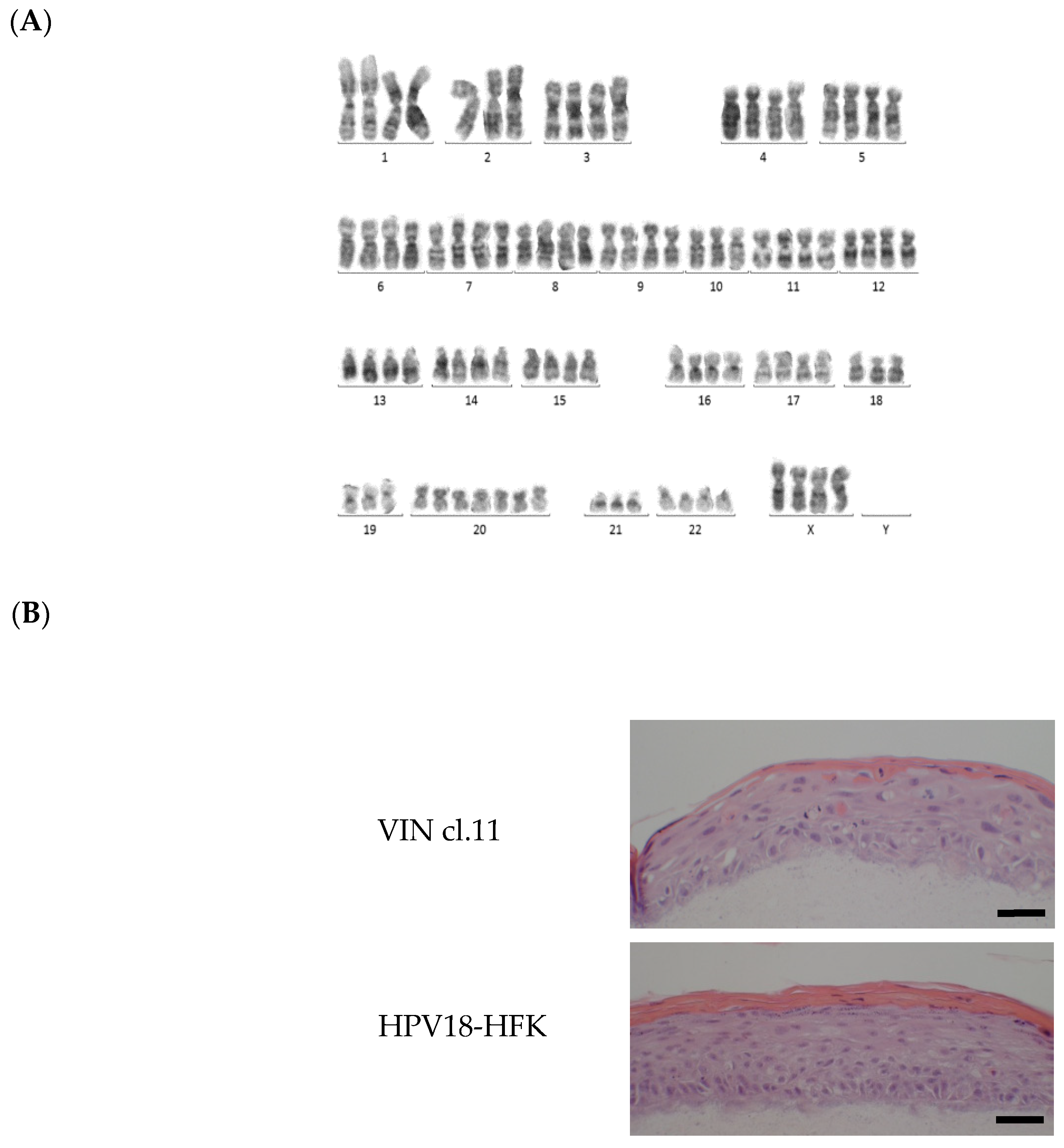
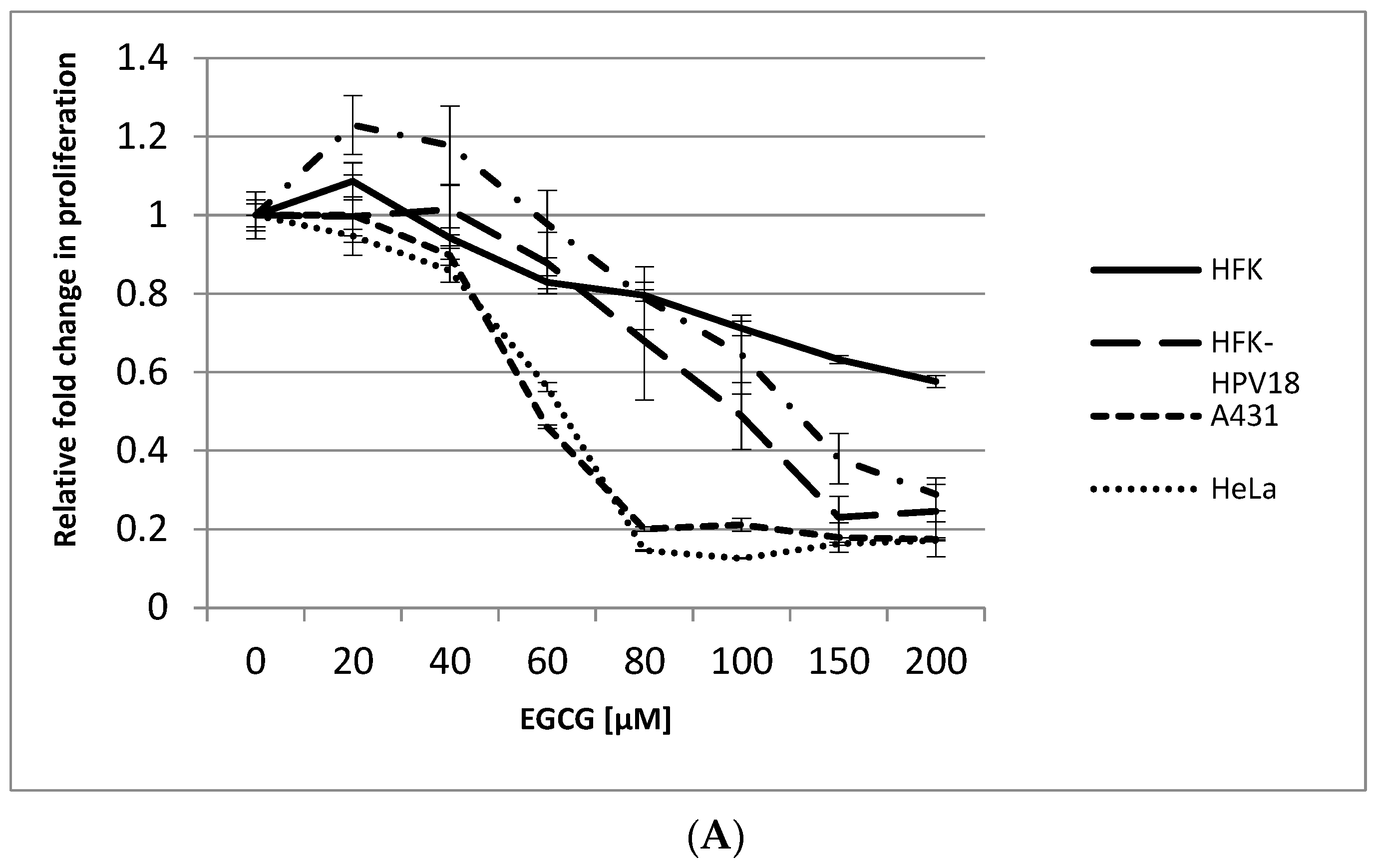
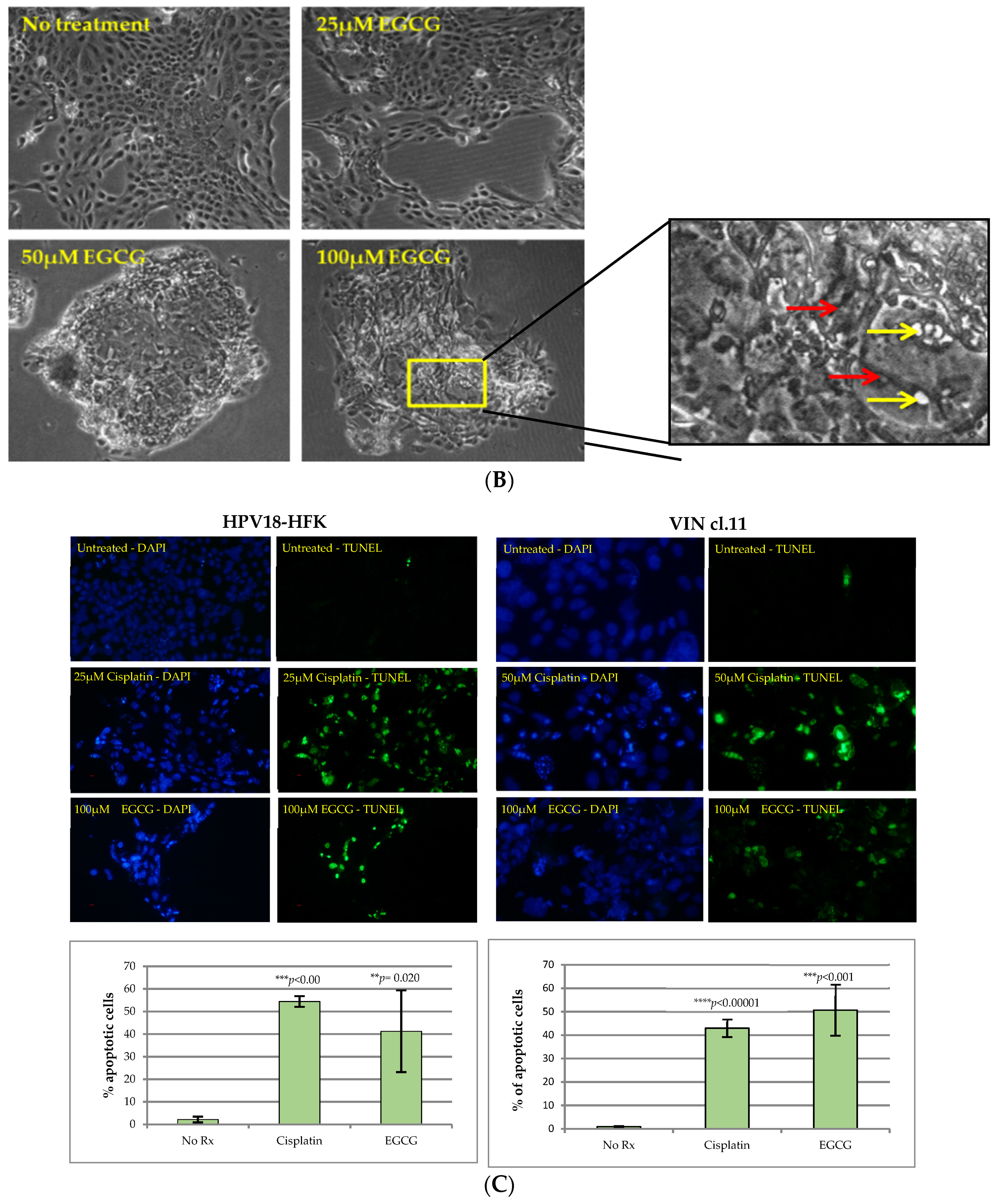
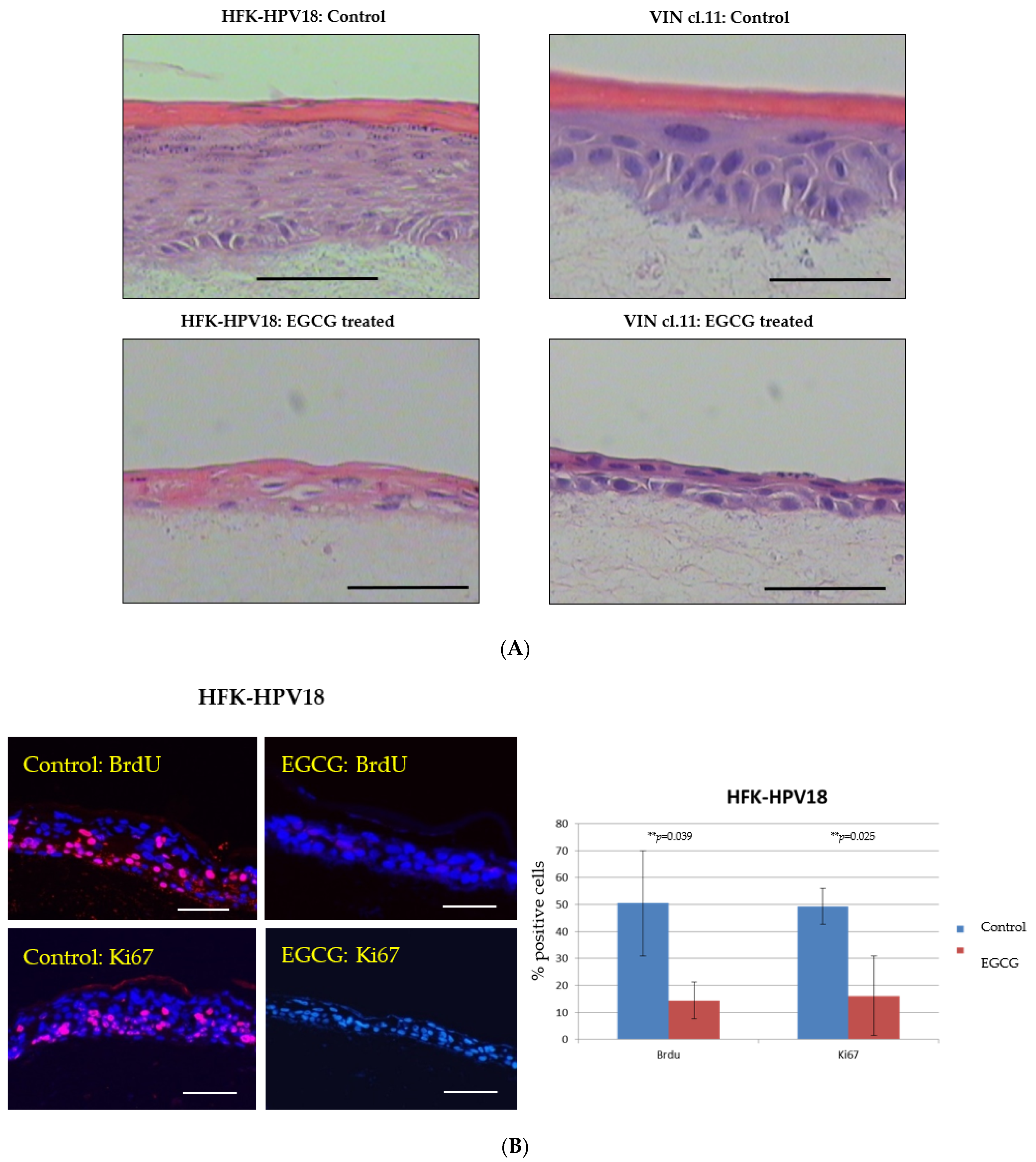
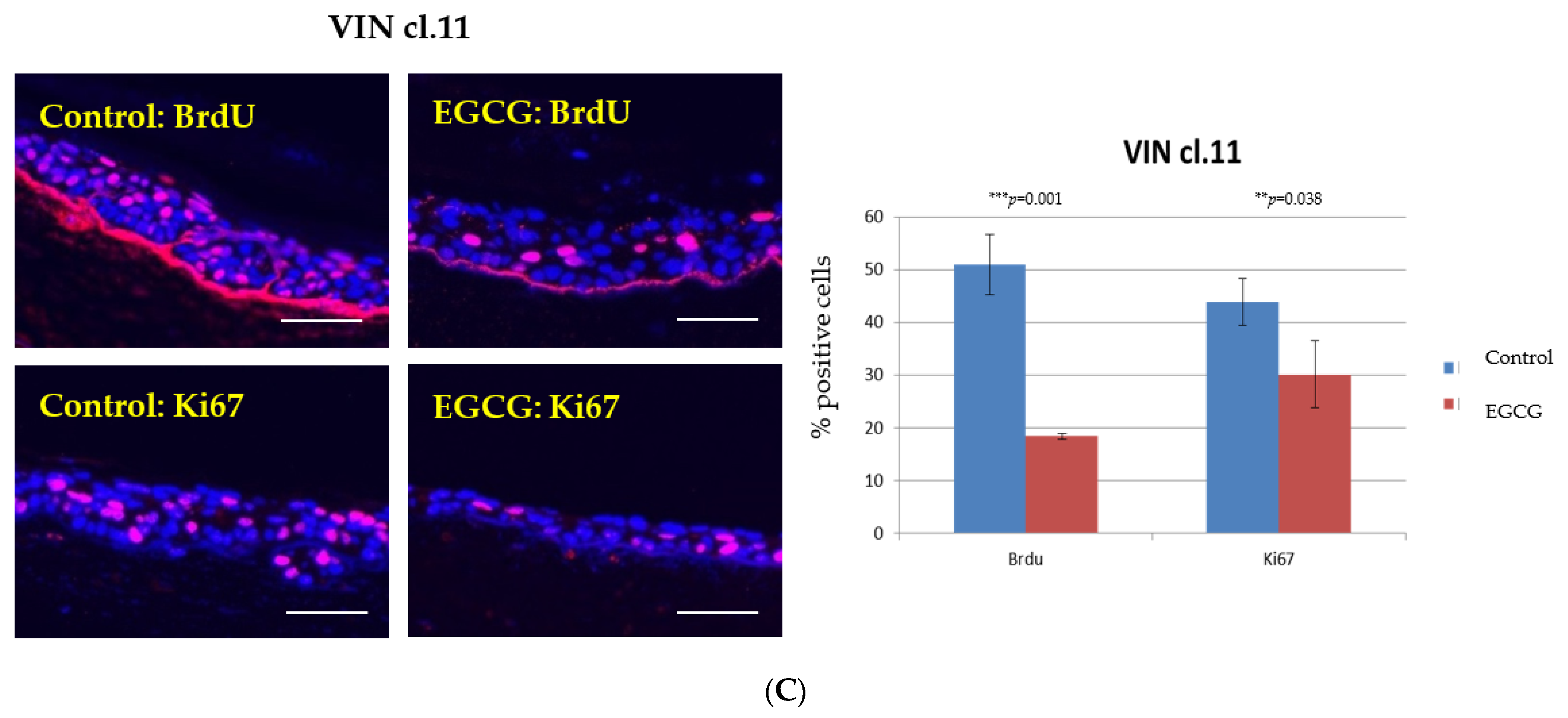
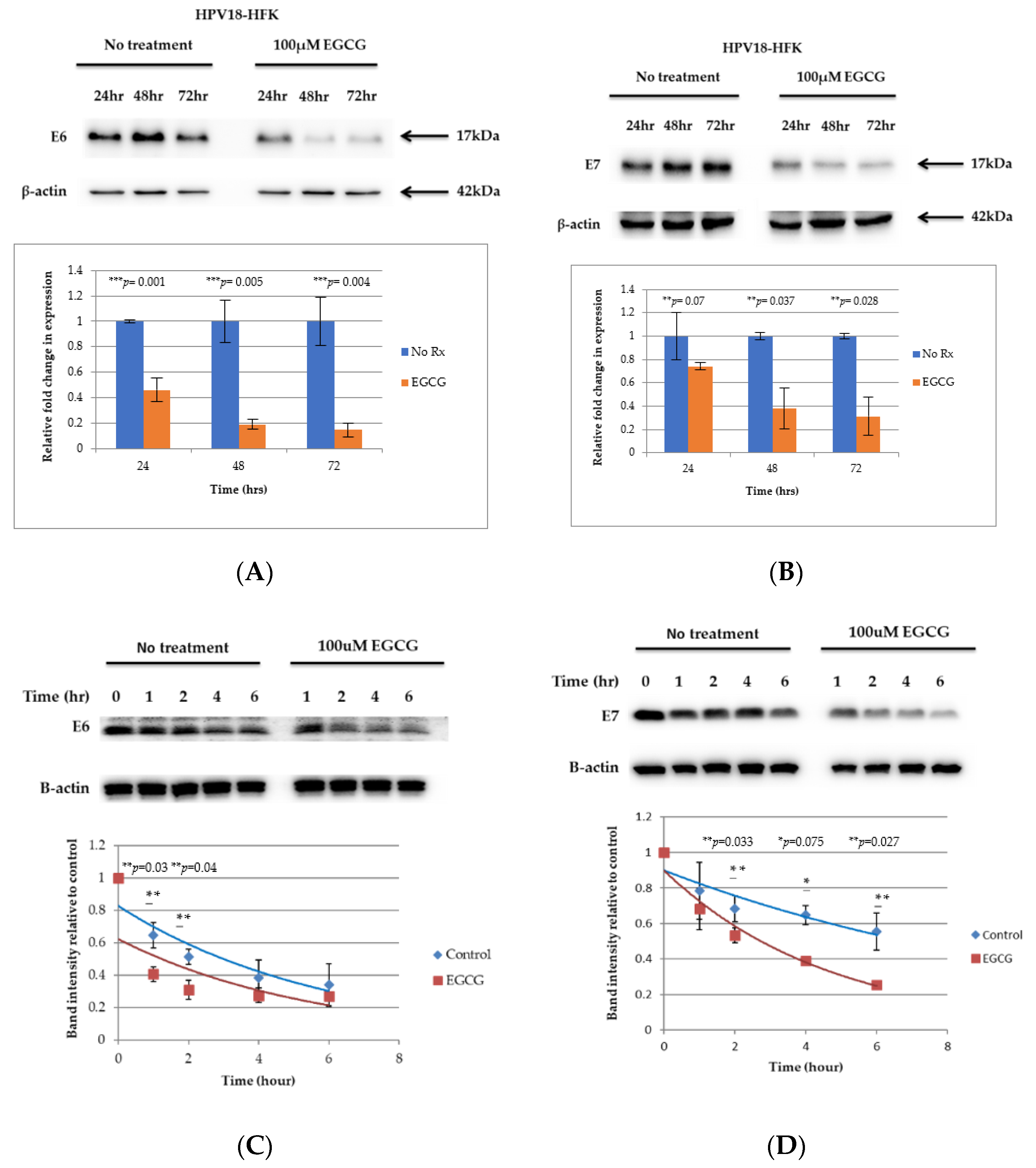
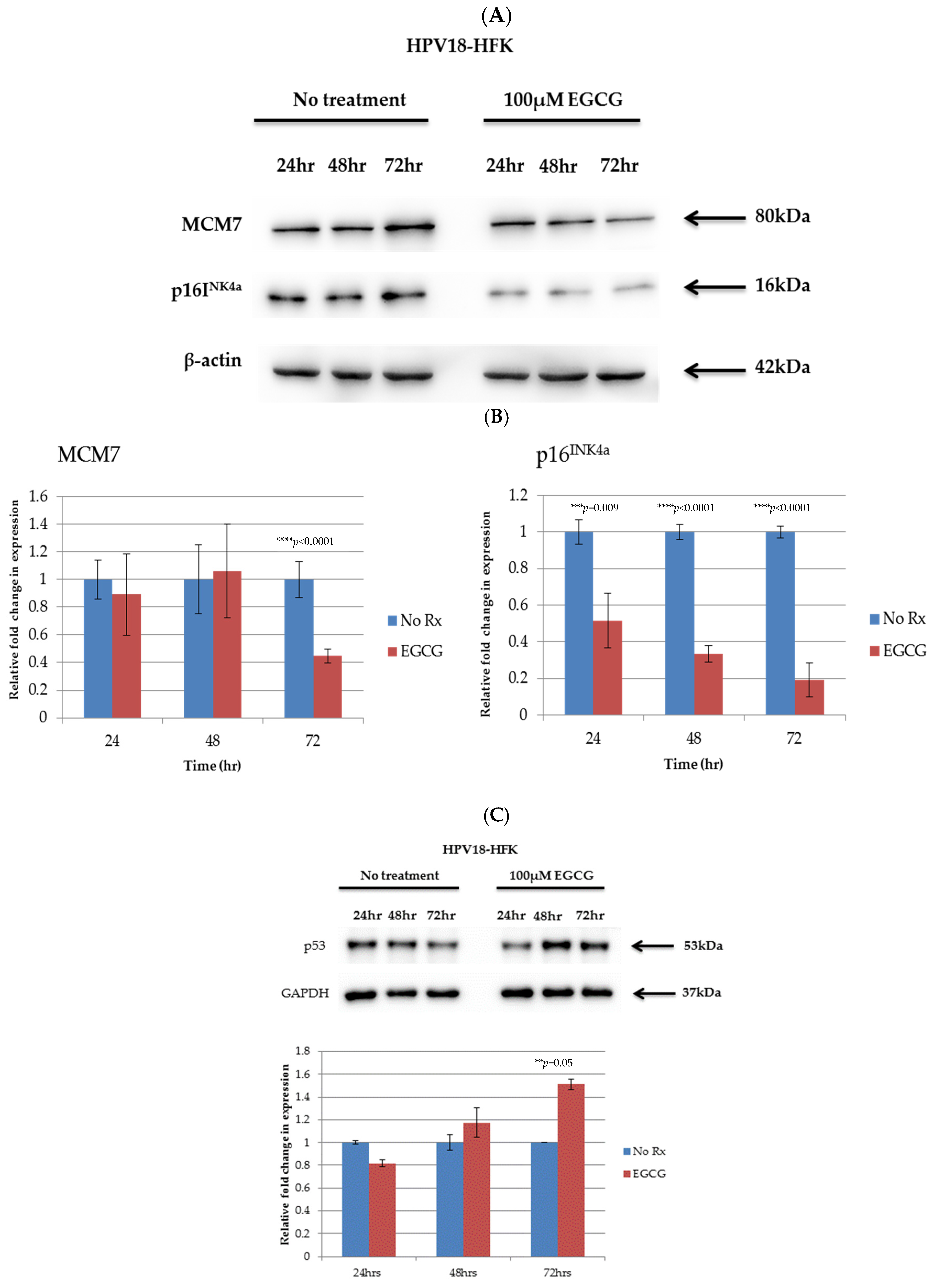
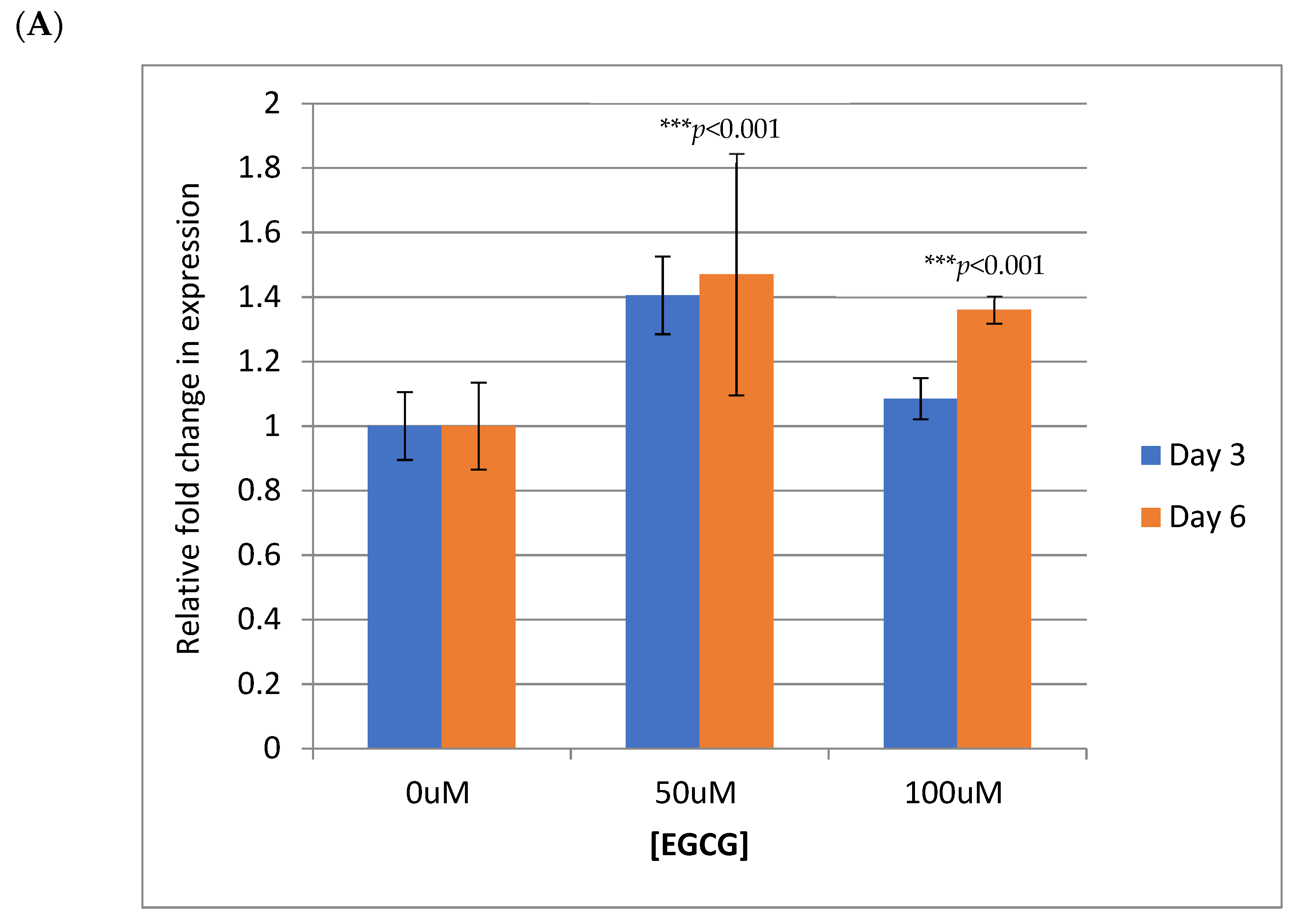
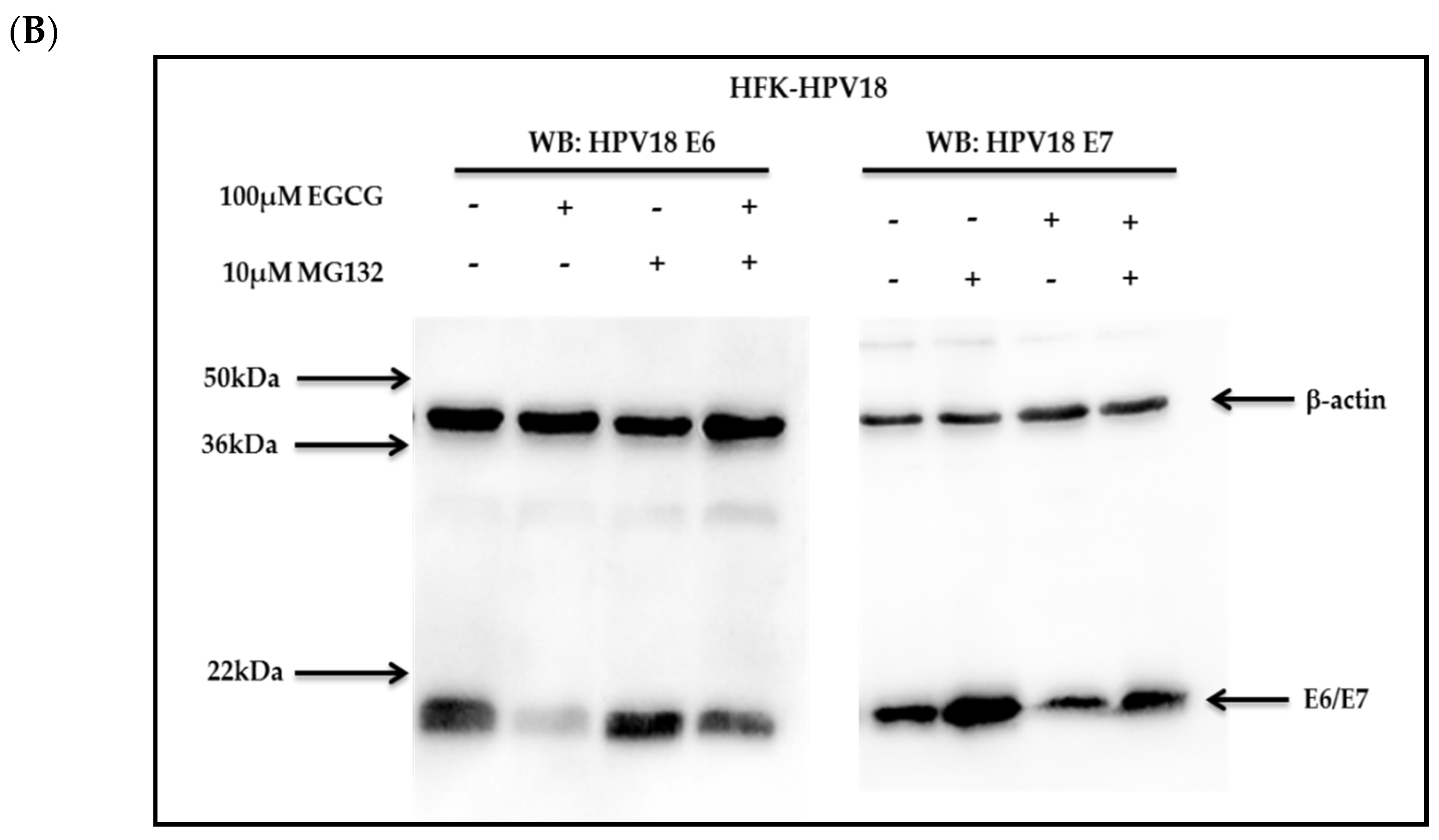
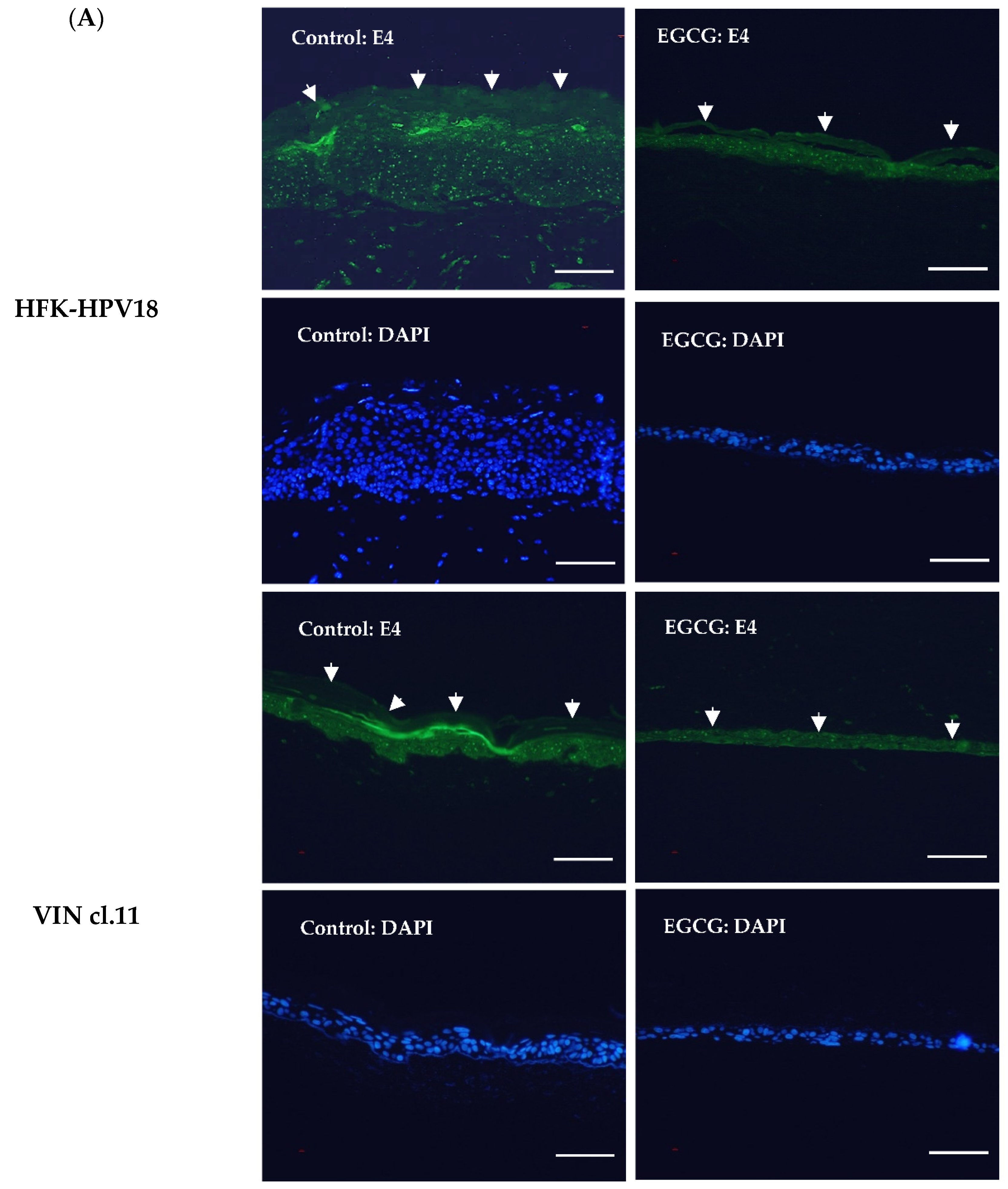
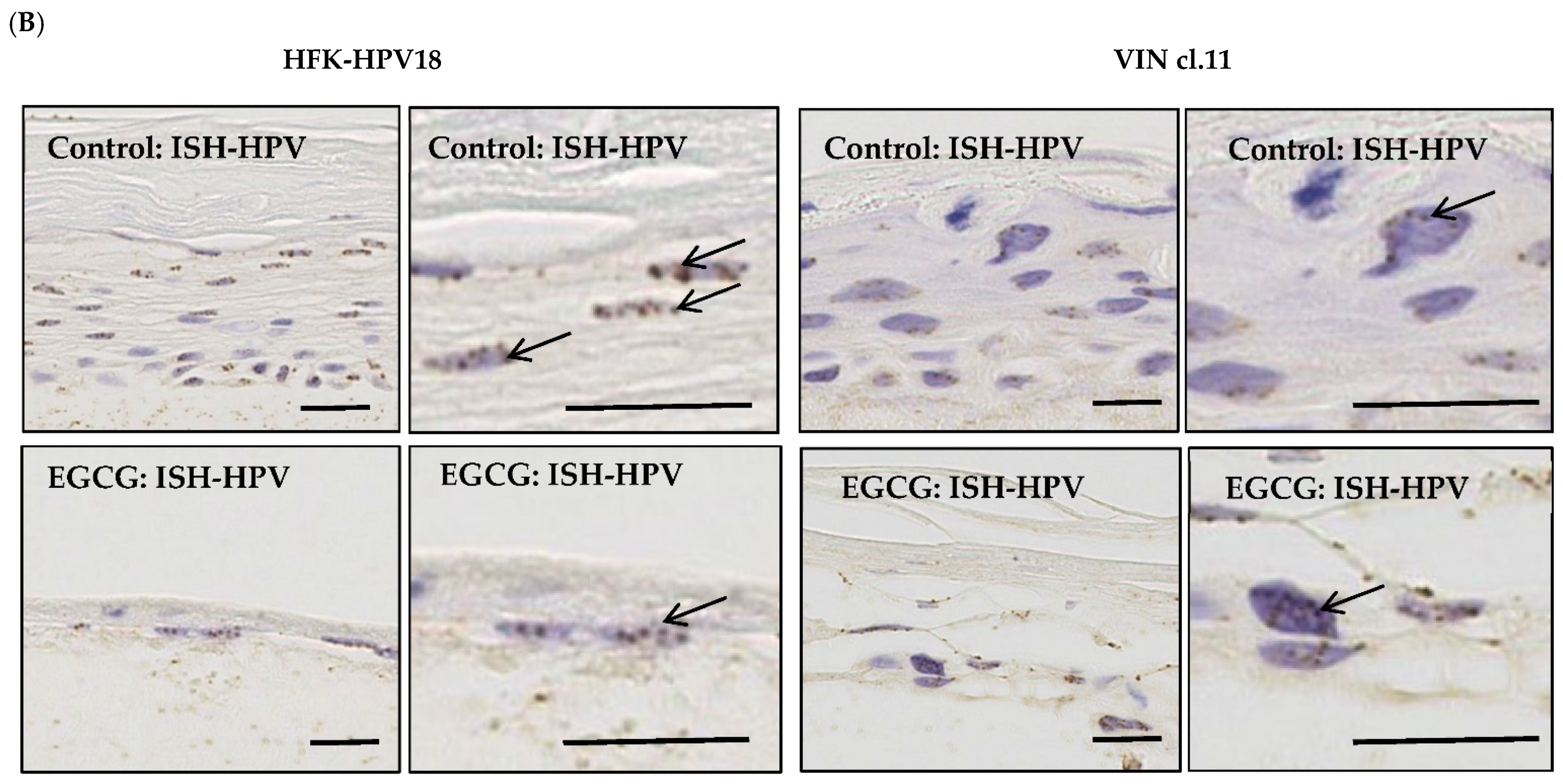
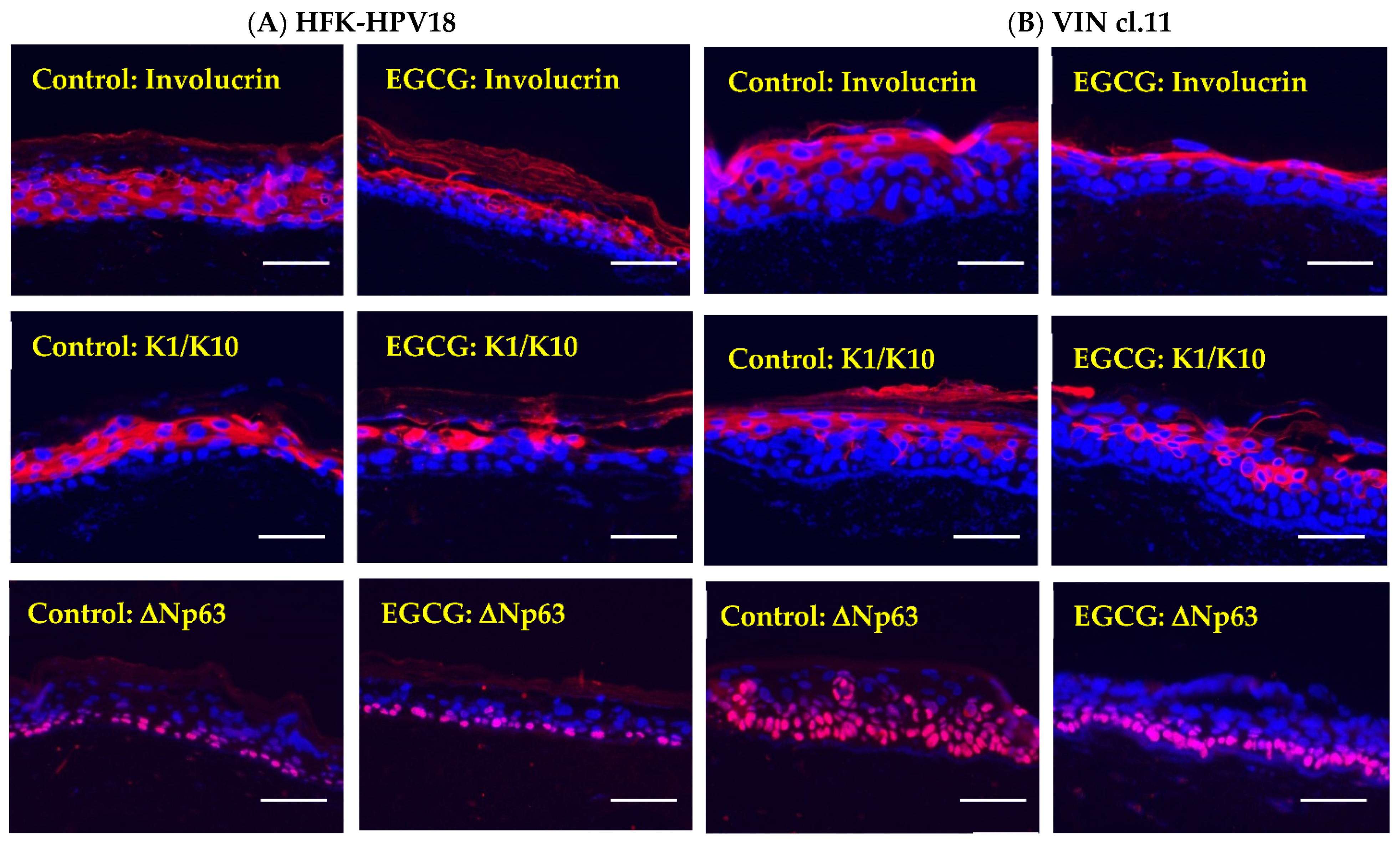
Publisher’s Note: MDPI stays neutral with regard to jurisdictional claims in published maps and institutional affiliations. |
© 2021 by the authors. Licensee MDPI, Basel, Switzerland. This article is an open access article distributed under the terms and conditions of the Creative Commons Attribution (CC BY) license (https://creativecommons.org/licenses/by/4.0/).
Share and Cite
Yap, J.K.W.; Kehoe, S.T.; Woodman, C.B.J.; Dawson, C.W. The Major Constituent of Green Tea, Epigallocatechin-3-Gallate (EGCG), Inhibits the Growth of HPV18-Infected Keratinocytes by Stimulating Proteasomal Turnover of the E6 and E7 Oncoproteins. Pathogens 2021, 10, 459. https://doi.org/10.3390/pathogens10040459
Yap JKW, Kehoe ST, Woodman CBJ, Dawson CW. The Major Constituent of Green Tea, Epigallocatechin-3-Gallate (EGCG), Inhibits the Growth of HPV18-Infected Keratinocytes by Stimulating Proteasomal Turnover of the E6 and E7 Oncoproteins. Pathogens. 2021; 10(4):459. https://doi.org/10.3390/pathogens10040459
Chicago/Turabian StyleYap, Jason K. W., Sean T. Kehoe, Ciaran B. J. Woodman, and Christopher W. Dawson. 2021. "The Major Constituent of Green Tea, Epigallocatechin-3-Gallate (EGCG), Inhibits the Growth of HPV18-Infected Keratinocytes by Stimulating Proteasomal Turnover of the E6 and E7 Oncoproteins" Pathogens 10, no. 4: 459. https://doi.org/10.3390/pathogens10040459
APA StyleYap, J. K. W., Kehoe, S. T., Woodman, C. B. J., & Dawson, C. W. (2021). The Major Constituent of Green Tea, Epigallocatechin-3-Gallate (EGCG), Inhibits the Growth of HPV18-Infected Keratinocytes by Stimulating Proteasomal Turnover of the E6 and E7 Oncoproteins. Pathogens, 10(4), 459. https://doi.org/10.3390/pathogens10040459





